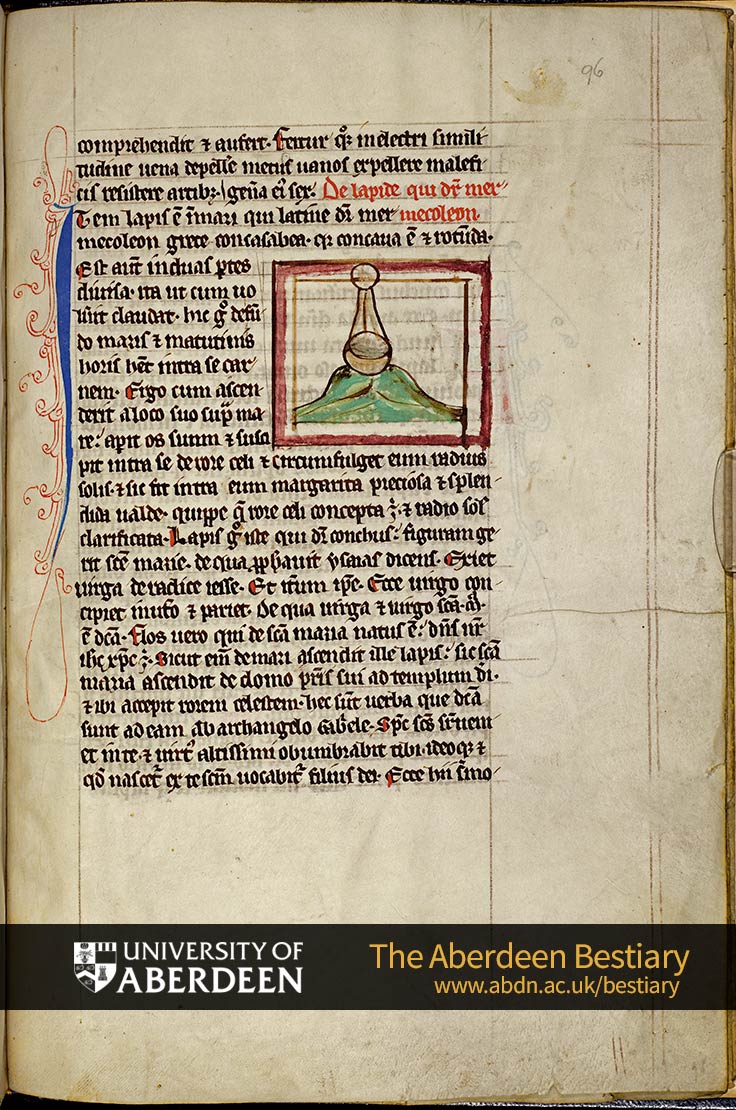Folio 96r - the adamas stone, continued. De lapide qui dicitur mermecoleon; Of the stone called mermecoleon
holds and bears away the metal.
They say also that it resembles amber, repelling poisons, banishing vain fears, resisting evil spells.
There are six kinds of adamant.
Of the stone called mermecoleon
There is a stone in the sea which is called in Latin mermecoleon and in Greek concasabea, because it is both hollow and round. It is, moreover, divided into two parts, so that if it wants to, it can close up.
The stone lies at the bottom of the sea and comes to life early in the morning. When it rises from its resting-place to the surface of the sea, it opens its mouth and takes in some heavenly dew, and the rays of the sun shine around it; thus there grows within the stone a most precious, shining pearl indeed, conceived from the heavenly dew and given lustre by the rays of the sun.
The stone, therefore, is called conchus; it symbolizes Saint Mary, of whom Isaiah foretold, saying: 'There shall come forth a rod out of the stem of Jesse' (Isaiah, 11:1). And again: 'Behold a virgin shall conceive and bear a son' (Isaiah, 7:14). Of the rod and the virgin, Saint Mary, it is said: 'A flower was born of Saint Mary, our Lord Jesus Christ'. For just as the stone rises from the sea, so Saint Mary went up from the house of her father to the temple of God and there received the dew from heaven. These are the words which were said to her by the archangel Gabriel: 'The Holy Ghost shall come upon thee, and the power of the Highest shall overshadow thee; therefore also that holy thing which shall be born of thee shall be called the Son of God' (Luke, 1:35). Behold these words
- Commentary
-
Commentary
Text
The mermecoleon, based on the description of an oyster producing a pearl.
Illustration
A poor sketch by the same hand as f.94r. The open stone, lying on green water, takes in the heavenly dew in order to grow a pearl.
Comment
Folio marks "II II" at the bottom of the page.
Folio Attributes
- Transcription and Translation
-
Transcription
comprehendit et aufert. Fertur quoque in electri simili\tudine ven[en]a depellere metus vanos expellere malefi\cis resistere artibus, genera eius sex.\ De lapide qui dicitur mermecoleon \ Item lapis est in mari qui Latine dicitur mer\ mecoleon Grece concasabea, quia concava est et rotunda.\ Est autem in duas partes\ divisa, ita ut cum vo\luerit claudat. Hic ergo de fun\do maris et matutinis\ horis habet intra se car\nem. Ergo cum ascen\derit a loco suo supra mare, aperit os suum et susci\pit intra se de rore celi et circumfulget eum radius\ solis, et sic fit intra eum margarita preciosa et splen\dida valde, quippe que rore celi concepta est, et radio solis\ clarificata. Lapis ergo iste qui dicitur conchus, figuram ge\rit sancte Marie, de qua prophetavit Isaias dicens: Exiet\ virga de radice Jesse. Et iterum ipse. Ecce virgo con\ cipiet in utero et pariet. De qua virga et virgo [virgine] sancta Maria\ est dicta: Flos vero qui de sancta Maria natus est, dominus noster\ Jesus Christus est. Sicut enim de mari ascendit ille lapis, sic sancta Maria ascendit de domo patris sui ad templum dei,\ et ibi accepit rorem celestem. Hec sunt verba que dicta\ sunt ad eam ab archangelo Gabriele: Spiritus sanctus superveni\et in te, et virtus altissimi obumbrabit tibi, ideoque et\ quod nascetur ex te sanctum vocabitur filius dei. Ecce hii sermo\Translation
holds and bears away the metal. They say also that it resembles amber, repelling poisons, banishing vain fears, resisting evil spells. There are six kinds of adamant. Of the stone called mermecoleon There is a stone in the sea which is called in Latin mermecoleon and in Greek concasabea, because it is both hollow and round. It is, moreover, divided into two parts, so that if it wants to, it can close up. The stone lies at the bottom of the sea and comes to life early in the morning. When it rises from its resting-place to the surface of the sea, it opens its mouth and takes in some heavenly dew, and the rays of the sun shine around it; thus there grows within the stone a most precious, shining pearl indeed, conceived from the heavenly dew and given lustre by the rays of the sun. The stone, therefore, is called conchus; it symbolizes Saint Mary, of whom Isaiah foretold, saying: 'There shall come forth a rod out of the stem of Jesse' (Isaiah, 11:1). And again: 'Behold a virgin shall conceive and bear a son' (Isaiah, 7:14). Of the rod and the virgin, Saint Mary, it is said: 'A flower was born of Saint Mary, our Lord Jesus Christ'. For just as the stone rises from the sea, so Saint Mary went up from the house of her father to the temple of God and there received the dew from heaven. These are the words which were said to her by the archangel Gabriel: 'The Holy Ghost shall come upon thee, and the power of the Highest shall overshadow thee; therefore also that holy thing which shall be born of thee shall be called the Son of God' (Luke, 1:35). Behold these words

